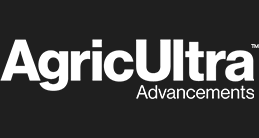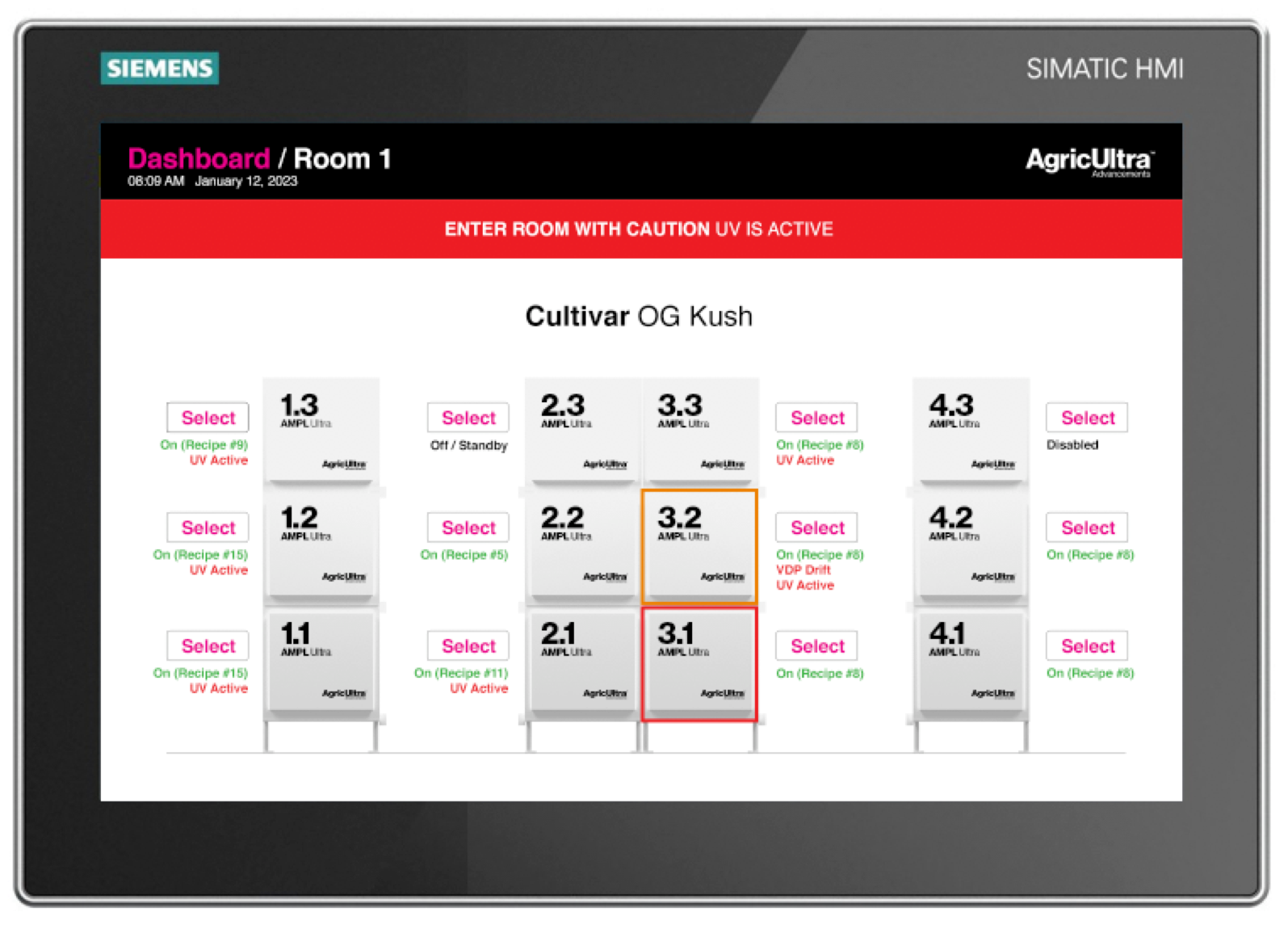The AMPL Automated Plant Factory
Our patented Push/Pull Ascending Airflow Technology achieves optimal environmental conditions around each plant in a facility regardless of its climatic requirements and location in a grow system. By effectively managing the byproducts of photosynthesis, heat generated by grow lights, and reducing evapotranspiration, AMPL greatly expands the variety and scale of crops that can be grown indoors. With AMPL, vertical farms are no longer limited to leafy greens.
Our Plant First™ approach to problem-solving and expertise in computational fluid dynamic modeling (CFD) made it clear that existing methods of vertical farming drastically underestimate the importance of airflow – Optimized air management is fundamental to the success of vertical farming at scale. AgricUltra Advancement™ has dedicated over half a decade to solving airflow management issues in commercial grow facilities which resulted in the development of the AMPL Platform.
The AMPL Platform is patented.
Why Airflow is Imperitive
Everything that a plant needs to thrive is governed by air control.
Water & Nutrients: A difference in pressure between water vapor within leaves and their ambient atmosphere enables plants to absorb water and nutrients through their roots. Without proper climate conditions, nutrients and water cannot be delivered to cells.
Optimal Gas Exchange: To maximize a plant’s ability to draw C0₂ and expel oxygen, plants require a dynamic balance of temperature, humidity, and air velocity.
Light: Without sufficient CO₂, photons are wasted which reduces the efficiency of grow lights.
A Mold & Pathogen Free Environment: Stagnant air provides ideal conditions for mold and pathogens that can cause disease.
AMPL™ Masters Airflow with Push/Pull Ascending Airflow
Treated Air is Pushed Upward
Conditioned, C0₂ enriched air is delivered to the base of each plant and pushed through the canopy equally down the length of each production layer.
Ascending airflow also reduces the often-overlooked issue of excess humidity caused by air movement over grow mediums
(Fig. 1). Reduced evapotranspiration results in less energy spent on dehumidification and eliminate grow medium parching.
Fig. 1 Horizontal and Descending vs. Ascending Airflow
Spent Air is Pulled Upward
Inter-canopy ducts remove the by-products of photosynthesis and problematic heat generated by grow lights directly at their source, removing spent air before it can degrade the surrounding environment. By abandoning the concept of spent and conditioned air mixing we have eliminated problematic microclimates and overcome the environmental limitations of multi-layer canopies grown indoors.
CDF Modelling has proven that multi-tier systems that do not remove excess heat and humidity at the canopy level experience accumulated environmental effects due to the unavoidable fact that hot air rises. Understanding and exploiting this fact leads back to our second design principle – Don’t fight physics. It’s inefficient.
Naturally occurring phenomena can be leveraged. Push/Pull Ascending Airflow takes advantage of the natural buoyancy of heat generated by grow lights, ascending airflow reduces CFM requirements, and does not decimate leaf boundary layers with high-velocity airflow required by horizontal and descending airflow methods at scale.
AMPL Precision Airflow Nozzles
Automotive-grade precision airflow nozzles can be adjusted to compensate for the unavoidable pressure drop that occurs as pressure changes down the length of a duct.
Custom nozzles and combinations of nozzles can be developed to:
1. Satisfy specific plant requirements
2. Achieve specific project goals
3. Achieve specific airflow patterns
CFD Model of Airflow Nozzle Combination
CFD model of balanced air velocity in an eight-layer AMPL Pro system (Side View).
Balanced Airflow has an Extraordinary Impact on Sensor Data Quality
By eliminating microclimates, sensors data quality can be far better relied upon to make meaningful decisions during production to adjust for crop variability and a grower’s ability to develop proprietary expressions of common genetics.
AgricUltra Advancements customizes human-machine interfaces (HMIs) for clients to match control and data collection requirements.
Optional Data Collection Points
• Plant Health
• Visual Imaging
• VDP
• Transpiration
• MicroCoil Efficiency
• Reheat Coil Temp
• Cooling Coil
• Relative Humidity
• Comparative Temperature
• Realtime Biomass
• Lighting Efficiency
• RHC / CC Temp Delta
• Fan Speed
• Irrigation Flow
• PH
• Nutrient Uptake
• QA
• Product Traceability
Please Note: Options vary depending on AMPL Model
AMPL Automation
The AMPL Platform integrates with widely adopted warehouse logistics systems without interfering with environmental systems; a result of our patent-pending Push/Pull Ascending Airflow system. This reduces the cost of automation and added the assurance of implementing the same systems used by some of the biggest companies in the world.
With AMPL’s ability to stack virtually unlimited canopies, warehouse automation has been an important design consideration. We have developed a robotic plant handler that attaches to third-party automated logistic systems to be used for a wide range of applications.
Robotic Plant Charge / Discharge,
Analysis & Treatment
The AMPL Plant Handler accesses grow shelves from both sides of the aisle, charging/discharging, analyzing, and tending to plants. Aeroponic chambers and hydroponic drip troughs are designed to be easily accessed by the handler.
Chamber/Trough Charge/Discharge
Targeted Spray System
Capabilities
• Charging and Discharging of Plants
• Real-Time Biometric Feedback
• Daily Biomass Monitoring
• Nutrient Uptake Rate Monitoring
• Optimizing Harvest Dates
• Determine Exact Yields
• Computer Visions Pathogen & Pest Identification
• Environmental Confirmation of Canopy Conditions
• Full Traceability Through Facility for Production QA
• Matching of Harvest Rates to Downstream Processing
• Make better-informed profit projections
• UV Plant treatment (Plant Health/Pathogen & Pest Control)
• Targeted Chemical Pathogen & Pest Treatment
• Environmental confirmation of canopy conditions.
• Targeted chamber/trough charge/discharge
• Robotic Arm Agnostic Mount (T-Slot System)
Sample Yield Calculation
This is an approximation. Values change based on crop requirements and logistics platforms.
Room Length: 55.5 m / 179’
Room Width: 30.5 m / 100’
Room Height: 15.25 m / 50’
Layer Height: 9
Row Count: 20
Plant Count per Cycle: 149,600
Energy Management
Beyond reducing environmental impact, hydronic energy management is just smart business. In colder climates, AMPL Ultra leverages outdoor temperatures to lower cooling costs. AMPL Ultra can be is easily integrate ground or lake geothermal strategies.
Implementing the AMPL’s Platform often qualifies producers for government environmental subsidies that offset capital costs.
Heat (43°C to 50°C / 110° F to 120° F) can be redirected for auxiliary purposes such as radiant heat flooring or circular economy production.
AMPL Ultra Energy Harvesting
AMPL Pro Energy Harvesting
As air is rapidly cooled to manage humidity it must be reheated before it enters the canopy. Spent air and heat captured from grow lights preheat the cold air before it crosses AMPL’s reheat coil. This results in a 30 to 50% reduction in energy costs vs. traditional bulk HVAC systems.
With AMPL’s Optional Energy Harvesting realizes a 30 - 50% reduction in energy costs vs. traditional bulk HVAC systems.
Reduction realized is dependent upon set point
conditions, type of lights used, and chiller type.
The Benefits of Optional UVB+A
Lighting Strategies
Improving Flavour, Taste & Potency with UVB
UVB is an intrinsic part of sunlight that is accompanied by significant biological effects. Plants are able to sense UVB using the UVB photoreceptor UVR8 which is linked to a specific molecular signaling pathway and leads to the accumulation of secondary metabolites that can improve the flavor, taste & potency of plants. UVB by itself can be dangerous to plants however when properly managed through exposure time and length, and additional light-mediated processes UV can define unique product characteristics. Talk to us about developing plant-specific lighting strategies.
Operate with a Greater Margin of Safety with UV Pathogen Control
UV is a highly effective wavelength for controlling mold and mildew (Fig. 4a, b) by reducing spore germination and mycelial growth. Given that UV’s effects are dose-dependent - with the right exposure time and frequency, UV penetrates through cell walls and disrupts the structure of DNA molecules (Fig. 5), prohibiting reproduction, effectively preventing mold colony growth, drastically reducing the need for human and chemical intervention.
Fig 4a Strawberries after 9 days in cold, dark storage control
Fig 4b UVB treated strawberries after 9 days in cold, dark storage
Increase Plant Resilience to
Pests & Pathogens
UVA-induced changes in plants include thicker leaves that are more resilient against insects and mold, while the UVR8 response produces higher levels of naturally occurring compounds that help protect some plants.
Pest Control
UV is commonly used to quarantine labs to keep potentially dangerous insects from escaping into the environment however at lower intensities in horticultural settings its effects vary between species and exposure times.
By using multiple channels and split wavelengths (285 nm / 385 nm), the UV effect can be had for up to 20 hours crossing the visible cycle and night cycles. This significantly limits the available habitat and resources for insects and increases the probability of interspecific interactions, such as competition and predation.¹¹
Insects eat less when they are exposed to UVB and UVA radiation,
causing less crop damage.¹⁰
Lethal effects of UVB have been reported for aphids and spider mites.⁹
UVB irradiation strongly decreases survivorship and egg production.¹⁰
Seamlessly Scale Research to Production
Scaling research from laboratory conditions to large-scale production poses a challenge to producers because test conditions do not match production environments. This is not the case with the AMPL Platform.
Conditions can be consistently translated from our small-scale AMPL Sprout R&D unit, from AMPL Ultra production layers, or between any AMPL Platform facilities.
AMPL Plant Factories are Available in Two types of Air Management Technology
AMPL Ultra™
An Independent Hydronic MicroCoil Based System
AMPL Ultra offers the ultimate in environmental control, energy management and flexible production. Independent MicroCoils turn each layer into its own growing environment, enabling growers to match output to market needs. AMPL Ultra is even capable of growing different crops on different layers**. Hydronic technology also eliminates the need for bulk air ducts, simplifying facility design. Modular production layer and facility components can be added as needed allowing for scaled growth; a highly desirable trait in emerging markets.
AMPL Ultra is an elegant solution for pharmaceutical horticulture and plant factories with unique output or architectural requirements.
AMPL Pro™
A Bulk Air Based Environmental System
AMPL Pro utilizes controlled bulk air diffusion and directed inter-canopy bulk air conditioning. This is the most cost-effective means of implementing Push/Pull Ascending Airflow in high-volume plant factories pending production goals.
AMPL Pro can facilitate staggered production to meet ever-changing market requirements. Bulk air entry air intake can be isolated to segregate setpoints between rows.



























